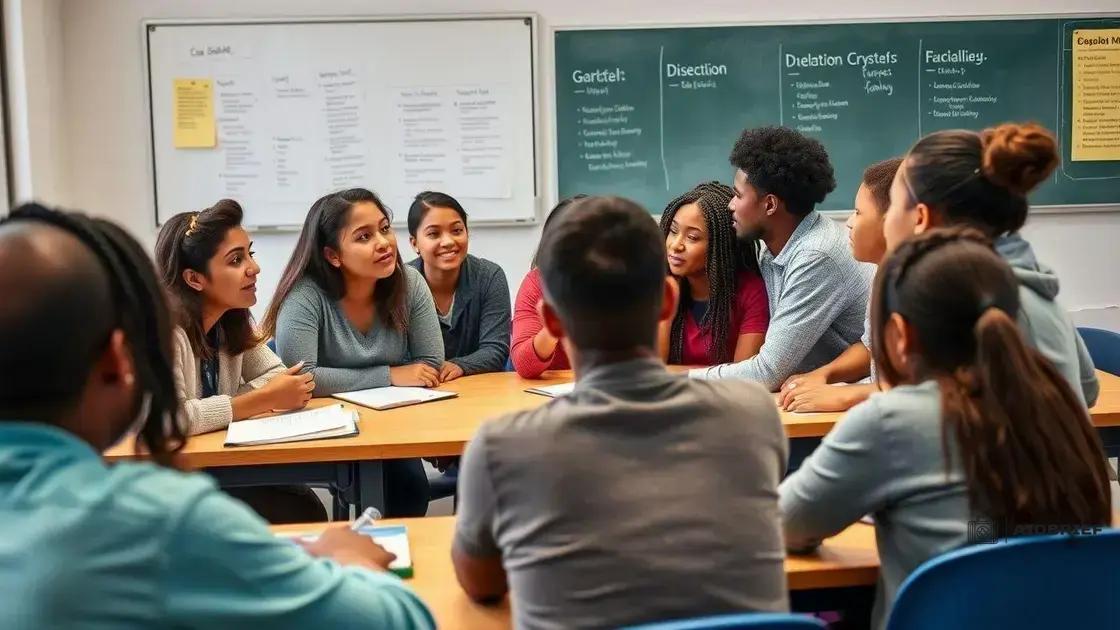Public education access legislation debates ignite change

Public education access legislation aims to ensure equitable access to quality education for all students, addressing barriers through funding, community engagement, and stakeholder collaboration.
Public education access legislation debates are shaping the future of our educational systems. Have you ever wondered how these discussions affect students and communities? Let’s dive into this crucial topic.
Understanding public education access legislation
Understanding public education access legislation is vital for anyone interested in the future of education. These laws aim to create an environment where every student, regardless of their background, has the opportunity to learn and succeed.
What Is Public Education Access Legislation?
This legislation refers to the rules and policies designed to ensure all students can access quality education. It focuses on eliminating barriers that hinder access, such as economic status, geographic location, or disability.
Key Components of the Legislation
Several important aspects make up these laws:
- Equity in funding across schools
- Inclusion of special education services
- Access to advanced resources and programs
These components work together to provide a well-rounded educational experience for everyone.
Moreover, understanding this legislation involves recognizing the role of various stakeholders, including school boards, governments, and community organizations. Each of these groups plays a part in shaping policies that affect students every day.
Impact on Students and Communities
The impact of public education access legislation extends to students and communities alike. When laws ensure access to quality education, they help students reach their full potential. This leads to stronger communities, as educated individuals contribute positively to society.
It is crucial to stay informed about how these laws evolve and affect us all. The discussions surrounding public education access legislation are ongoing and require our attention to foster meaningful change.
Key stakeholders in the debates
Understanding the key stakeholders in the debates surrounding public education access legislation is crucial. These stakeholders play a significant role in shaping policies that impact students and schools.
Government officials and policymakers
Government officials, including legislators and education department leaders, are vital in creating and implementing education laws. Their decisions can dictate funding, resources, and overall policy direction. They often listen to community feedback to understand the needs of constituents.
Educators and school administrators
Teachers and school leaders are on the front lines of education. They provide direct input based on their experiences in the classroom. Their perspectives help inform lawmakers about what resources are needed for effective teaching and learning.
- Advocacy for better funding
- Identifying barriers to student success
- Sharing successful teaching strategies
Additionally, educators often collaborate with administrators to develop programs that support student learning, ensuring that all students have access to quality education.
Parents and community members
Parents and community members have a powerful voice in educational debates. They bring concerns and hopes for their children’s education to the forefront. Grassroots movements often emerge from these groups, advocating for changes that resonate deeply within the community.
Understanding how various stakeholders interact can highlight the complexities of education access debates. Each group’s insights contribute to a richer discussion about what equitable education looks like and how to achieve it.
Relationships among these stakeholders can lead to collaborative efforts and innovative solutions, ensuring that the legislation stays relevant and effective.
Impact of recent legislation on communities

The impact of recent legislation on communities plays a crucial role in shaping the educational landscape. New laws can either enhance or hinder access to quality education, affecting students, families, and local economies.
Positive Changes from Legislation
Many communities have seen improvements thanks to new legislation aimed at increasing funding and resources. This includes:
- Enhanced support for low-income schools
- Increased access to technology and learning materials
- Programs tailored for special education
These changes help ensure that all students, regardless of their background, receive a better chance at success. Community engagement also rises when families see their schools improving, leading to more parents involved in educational activities.
Challenges Faced by Communities
However, not all changes have been beneficial. Some communities struggle with the implementation of laws that require quick adaptations. For instance, a sudden shift in funding might leave some schools without adequate resources while others benefit disproportionately. This can create confusion and further inequalities among students.
Additionally, communities may face complications when legislation does not align with local needs. It is essential for lawmakers to listen to community feedback to make meaningful adjustments.
Understanding the impact of recent legislation helps communities advocate for their needs effectively. When local voices are heard in the legislative process, the potential for positive change increases significantly.
Challenges in implementing education laws
The challenges in implementing education laws are significant issues that affect many stakeholders, including students, parents, and educators. Even well-intentioned policies may face obstacles that hinder their effectiveness.
Funding and Resource Allocation
One major challenge is the availability of adequate funding. Many education laws require substantial financial investments to succeed. Without proper funding, schools struggle to implement new programs or resources effectively.
Budget constraints can lead to:
- Insufficient hiring of qualified staff
- Inadequate materials and technology
- Limited support for special education programs
When schools do not have the resources they need, legislation can fall short of its goals, affecting student outcomes.
Resistance to Change
Another challenge arises from resistance to change within schools and communities. Implementing new laws often requires adjustments to established practices. Teachers and administrators may feel overwhelmed or skeptical about new requirements.
This can lead to:
- Inconsistent application of policies
- Lack of engagement from educators
- Challenges in professional development efforts
Furthermore, without proper training and support, educators may struggle to adapt to new legislation, which can hinder student learning.
Collaboration among stakeholders is essential in overcoming these challenges. When schools, communities, and policymakers work together, they can create a more supportive environment for implementing laws effectively. Understanding these challenges in implementing education laws is the first step towards finding solutions that benefit everyone involved.
Future trends in education access discussions
The future trends in education access discussions are evolving as society recognizes the importance of equitable education for all students. As we move forward, new ideas and technologies will shape how education is delivered and accessed.
Technology Integration
One of the most significant trends is the integration of technology in education. Online learning platforms and digital resources are becoming essential. These tools offer flexibility and allow students to learn at their own pace.
Key aspects of this trend include:
- Increased use of virtual classrooms
- Access to online resources and courses
- Tools for personalized learning experiences
With technology, education can reach students in remote areas, breaking down geographical barriers.
Focus on Mental Health and Well-Being
Another trend gaining attention is the focus on mental health and well-being in schools. Recognizing that students’ emotional health is linked to their academic success is crucial. Programs that support mental health are becoming integral to education strategies.
These programs aim to:
- Provide resources for stress management
- Encourage social-emotional learning
- Promote supportive school environments
Schools fostering a culture of support help ensure all students have a positive learning experience.
Community and Parental Engagement
Future discussions about education access will increasingly involve community and parental engagement. Building partnerships between schools and families can lead to better outcomes for students. Schools that actively seek input from parents can tailor their programs to better meet local needs.
Collaboration across stakeholders is essential for addressing barriers to education. By harnessing the power of communities, we can drive effective change and improve access for all students.
As we look towards the future, staying informed about these future trends in education access discussions is essential for making meaningful progress in educational equity.
FAQ – Frequently Asked Questions about Public Education Access Legislation
What is public education access legislation?
Public education access legislation refers to laws aimed at ensuring every student has equitable access to quality education, regardless of their background.
Who are the key stakeholders in education access discussions?
Key stakeholders include government officials, policymakers, educators, parents, and community members who all play a role in shaping education policies.
What are some challenges in implementing education laws?
Challenges include inadequate funding, resistance to change from educators, and disparities in resource allocation that can hinder effective implementation.
What are the future trends in education access discussions?
Future trends include the integration of technology in education, a focus on mental health and well-being, and increased engagement from communities and parents.





